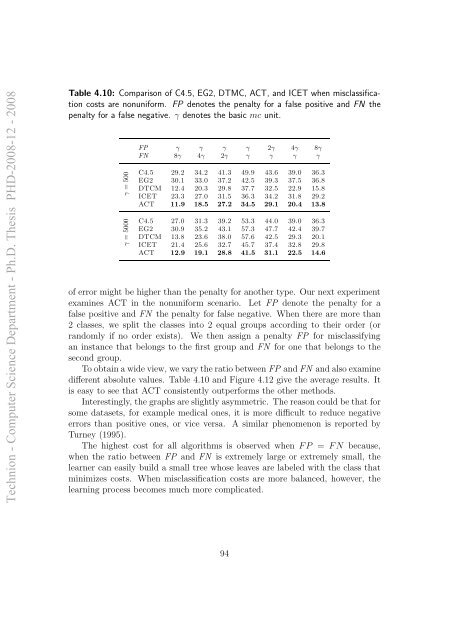anytime algorithms for learning anytime classifiers saher ... - Technion
anytime algorithms for learning anytime classifiers saher ... - Technion
anytime algorithms for learning anytime classifiers saher ... - Technion
Create successful ePaper yourself
Turn your PDF publications into a flip-book with our unique Google optimized e-Paper software.
<strong>Technion</strong> - Computer Science Department - Ph.D. Thesis PHD-2008-12 - 2008<br />
Table 4.10: Comparison of C4.5, EG2, DTMC, ACT, and ICET when misclassification<br />
costs are nonuni<strong>for</strong>m. FP denotes the penalty <strong>for</strong> a false positive and FN the<br />
penalty <strong>for</strong> a false negative. γ denotes the basic mc unit.<br />
γ = 500<br />
γ = 5000<br />
FP γ γ γ γ 2γ 4γ 8γ<br />
FN 8γ 4γ 2γ γ γ γ γ<br />
C4.5 29.2 34.2 41.3 49.9 43.6 39.0 36.3<br />
EG2 30.1 33.0 37.2 42.5 39.3 37.5 36.8<br />
DTCM 12.4 20.3 29.8 37.7 32.5 22.9 15.8<br />
ICET 23.3 27.0 31.5 36.3 34.2 31.8 29.2<br />
ACT 11.9 18.5 27.2 34.5 29.1 20.4 13.8<br />
C4.5 27.0 31.3 39.2 53.3 44.0 39.0 36.3<br />
EG2 30.9 35.2 43.1 57.3 47.7 42.4 39.7<br />
DTCM 13.8 23.6 38.0 57.6 42.5 29.3 20.1<br />
ICET 21.4 25.6 32.7 45.7 37.4 32.8 29.8<br />
ACT 12.9 19.1 28.8 41.5 31.1 22.5 14.6<br />
of error might be higher than the penalty <strong>for</strong> another type. Our next experiment<br />
examines ACT in the nonuni<strong>for</strong>m scenario. Let FP denote the penalty <strong>for</strong> a<br />
false positive and FN the penalty <strong>for</strong> false negative. When there are more than<br />
2 classes, we split the classes into 2 equal groups according to their order (or<br />
randomly if no order exists). We then assign a penalty FP <strong>for</strong> misclassifying<br />
an instance that belongs to the first group and FN <strong>for</strong> one that belongs to the<br />
second group.<br />
To obtain a wide view, we vary the ratio between FP and FN and also examine<br />
different absolute values. Table 4.10 and Figure 4.12 give the average results. It<br />
is easy to see that ACT consistently outper<strong>for</strong>ms the other methods.<br />
Interestingly, the graphs are slightly asymmetric. The reason could be that <strong>for</strong><br />
some datasets, <strong>for</strong> example medical ones, it is more difficult to reduce negative<br />
errors than positive ones, or vice versa. A similar phenomenon is reported by<br />
Turney (1995).<br />
The highest cost <strong>for</strong> all <strong>algorithms</strong> is observed when FP = FN because,<br />
when the ratio between FP and FN is extremely large or extremely small, the<br />
learner can easily build a small tree whose leaves are labeled with the class that<br />
minimizes costs. When misclassification costs are more balanced, however, the<br />
<strong>learning</strong> process becomes much more complicated.<br />
94











